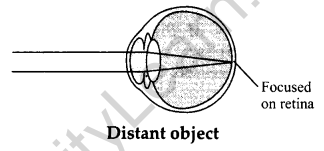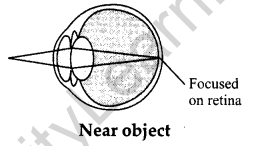Table of Contents
Time allowed: 3 hours
Maximum marks: 80
General Instructions:
- The question paper comprises five Sections, A, B, C, D and E. You are to attempt All the sections.
- All questions are compulsory.
- Internal choice is given in Sections B, C, D and E.
- Questions number 1 and 2 in Section A are one-mark questions. They are to be answered in one word or in one sentence.
- Questions number 3 to 5 in Section B are two-marks questions. These are to be answered in about 30 words each.
- Questions number 6 to 15 in Section C are three-marks questions. These are to be answered in about 50 words each.
- Questions number 16 to 21 in Section D are five-marks questions. These are to be answered in about 70 words each.
- Questions number 22 to 27 in Section E are based on practical skills. Each question is a two-marks question. These are to be answered in brief.
CBSE Previous Year Question Papers Class 10 Science 2017 Delhi Term 2 Set I
Section – A
Question 1.
Write the molecular formula of first two members of homologous series having functional group-Cl. [1]
Answer:
The general formula for the homologous series of a functional group -Cl is CnH2n+1Cl.
- CH3Cl
- CH3CH2Cl
Question 2.
Name the method by which spirogyra reproduces under favourable conditions. Is this method sexual or asexual? [1]
Answer:
Under favourable conditions, spirogyra reproduces by fragmentation. This is an asexual method of reproduction.
Question 3.
What is an ecosystem? [1]
Answer:
An ecosystem is a self sustaining system where biotic and abiotic organisms of various communities interact with each other. Ponds, forests, grasslands etc., are a few examples of ecosystem.
Question 4.
An object is placed at a distance of 30 cm in front of a convex mirror of focal length 15 cm. Write four characteristics of the image formed by the mirror. [2]
Answer:
Given: u = -30 cm, f = 15 cm.
We know that,
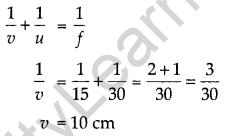
Characteristics of image:
- Image formed is erect.
- Image formed is small in size.
- Image formed is virtual.
- Image is formed at a distance of 10 cm behind the mirror between focus and pole.
Question 5.
What is sustainable management? Why is reuse considered better in comparison to recycle? [2]
Answer:
Sustainable management is a resource management technique which aims to conserve the resource, use them efficiently and avoid their misuse for individual purpose such that they are conserved for the future.
Reuse is better than recycle because of following reasons:
- Recycling needs some processes to use the same material again.
- Reuse saves energy by using same material again without any changes.
- Reuse prevents environmental pollution by not creating any waste.
- Reuse saves cost as material is used again without any process.
Question 6.
Management of forest and wildlife resources is a very challenging task. Why? Give any two reasons. [2]
Answer:
Management of the forest and wildlife resources is considered as a challenging task because:
- There are many stakeholders of forest. They are those people who are directly or indirectly involved in forest. Management of forest and wildlife has to take into account the interests of all these stakeholders which becomes a challenging task.
- Industries would consider the forest as merely a source of raw material for its factories and huge interest groups lobby the government for access to these raw materials at artificially low rates which further poses a challenge to manage the forest and wildlife resources.
Question 7.
Two carbon compounds X and Y have the molecular formula C4H8 and C5H12 respectively. Which one of these is most likely to show addition reaction? Justify your answer. Also, give the chemical equation to explain the process of addition reaction in this case. [3]
Answer:
X = C4H8 is an alkene.
Y = C5H12 is an alkane.
X being an alkene i.e., butene is unsaturated compound and will show addition reaction as they have free electrons for bonding.
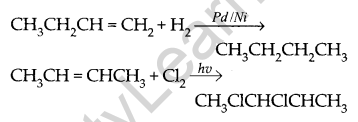
Question 8.
Complete the following chemical equations: [3]

Answer:
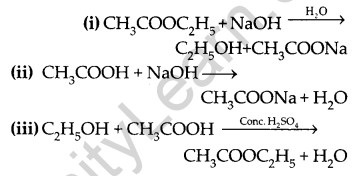
Question 9.
Write the names given to the vertical columns and horizontal rows in the Modem Periodic Table. How does the metallic character of elements vary on moving down a vertical column? How does the size of the atomic radius vary on moving left to right in a horizontal row ? Give reason in support of your answer in the above two cases. [3]
Answer:
Vertical columns in Modem periodic table are called groups and horizontal rows are called periods. As we move down the group metallic character increases as the atomic size increases, force of attraction between nucleus and outermost shell decreases so tendency to lose ions increases. When we move left to right in period, the number of electrons in the same shell increases leading to greater electrostatic attraction between nucleus and outermost electron. This increased attraction pulls the outermost electron closer to the nucleus, thereby decreasing the atomic size.
Question 10.
An element P (atomic number 20) reacts with an element Q (atomic number 17) to form a compound. Answer the following questions giving reason:
Write the position of P and Q in the Modem Periodic Table and the molecular formula of the compound formed when P reacts with Q. [3]
Answer:
P = 20 ; 2, 8, 8, 2
Q = 17 ; 2, 8, 7
P = Period 4 and Group 2
Q = Period 3 and Group 17
Hence formula of the compound formed between P and Q is PQ2.
Question 11.
What happens when: [3]
- Accidently, Planaria gets cut into many pieces?
- Bryophyllum leaf falls on the wet soil?
- On maturation sporangia of Rhizopus bursts?
Answer:
- When planaria get cut into many pieces, it will undergo a process known as regeneration due to which each piece will grow into a new Planaria organism.
- When Bryophyllum leaf falls on the wet soil, the buds that are produced in the notches along the leaf will develop into new plants by the process known as vegetative propagation.
- When the sporangia of Rhizopus bursts on maturation, the spores present inside it spread in the open environment. Then, with the help of different agents, they are carried to different places and when they land on a favourable surface, they start growing and produce a new organism.
Question 12.
State the basic requirement for sexual reproduction. Write the importance of such reproduction in nature. [3]
Answer:
The basic requirements for sexual reproduction to take place is the involvement of two parents and fusion of their haploid gametes. In the sexual reproduction, a new individual is formed which is diploid in nature, the gametes, one from the male parent and the other from the female parent. Since the new individual formed is diploid in nature, the gametes must be formed by meiosis, so that chromosome number can be reduced to half. When fusion of gametes occurs, the nuclei of these two gametes fuse and the chromosome number is then restored to normal. The zygote, thus, formed is diploid in nature.
Importance of sexual reproduction:
- Sexual reproduction involves fusion of male and female gametes from both the parents, thus results in genetic variations in the offsprings.
- Sexual reproduction promotes diversity of characters in offsprings by providing genetic variations.
- These genetic variations, thus lead to evolution of species as well as allow the organisms to become better adapted in the changing environment.
Question 13.
State the changes that take place in the uterus when:
(a) Implantation of embryo has occurred.
(b) Female gamete/egg is not fertilised. [3]
Answer:
(a) When implantation has occurred in uterus of the mother, the inner lining of the uterus thickens and is richly supplied with the blood vessels to provide nourishment to the growing embryo.
(b) If the egg is not fertilised, it lives for about one day. Since, the thickened uterus lining is no more required, it will slowly breakdown and comes out through the vagina as blood and mucous known as menstruation which lasts for about two to eight days.
Question 14.
Distinguish between the acquired traits and the inherited traits in tabular form, giving one example for each. [3]
Answer:
| S. No. | Acquired traits | Inherited traits |
| 1. | Acquired traits are those that are developed by an individual during his/her lifetime. | Inherited traits are the qualities or characteristics present in an individual since birth. |
| 2. | They are the result of changes in non-reproductive tissues. | They are the result of changes in the DNA. |
|
3. |
They cannot be passed on to the progeny, e.g., Pierced ear, large muscle size etc. | They are transmitted to the progeny, e.g., Colour of eyes, skin or hair colour etc. |
Question 15.
Explain with the help of an example each, how the following provides evidence in favour of evolution: [3]
(a) Homologous organs
(b) Analogous organs
(c) Fossils
Answer:
(a) Homologous organs: These organs are similar in form but perform different functions in different organisms. These organs provide strong evidence in favour of evolution. For example : the bone structure observed in the fore limbs of birds and bats, flippers of dolphins and arms of human beings are similar and have same pentadactyl plan but they perform different functions.
(b) Analogous organs: These organs have different origin and different basic structure but perform same functions. For example, wings of birds and wings of bat have different structures but perform same function of flying. Thus, these organs provide evidences for evolution that they are different in origin but evolved to perform same function to survive in hostile environmental conditions.
(c) Fossils: Fossils are the preserved remains or traces of animals, plants and other organisms from the remote past. For example, Archaeopteryx is a connecting link between birds and reptiles and it suggests that the present animals have evolved from the existing ones through the process of continuous evolution.
Question 16.
An object 4 cm in height, is placed at 15 cm in front of a concave mirror of focal length 10 cm. At what distance from the mirror should a screen be placed to obtain a sharp image of the object. Calculate the height of the image. [3]
Answer:
Given: u = -1.5 cm, f = -10 cm, h0 = 4 cm
Using the mirror formula
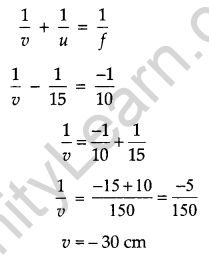
Thus, to obtain a sharp image of the object, the screen should be placed in front of the mirror at a distance of 30 cm.
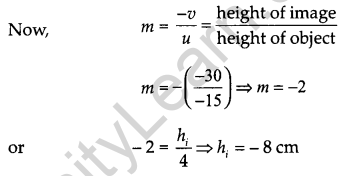
Height of the image is 8 cm. (inverted)
Question 17.
Due to gradual weakening of ciliary muscles and diminishing flexibility of the eye lens a certain defect of vision arises. Write the name of this defect. Name the type of lens required by such persons to improve the vision. Explain the structure and function of such a lens. [3]
Answer:
The defect caused due to gradual weakening of ciliary muscles and diminishing flexibility of the eye lens is presbyopia. Presbyopia is the defect of eye in which a person cannot see nearby objects comfortably and distinctly without corrective eye glasses. A presbyopic eye has its near point greater than 25 cm and gradually increases as the eye becomes older. The type of lens required by such person to improve the vision is bifocal lens.
A bifocal lens consists of both convex and concave lenses. The convex lens used in bifocal lens is used to correct hypermetropia (farsightedness) and concave lens is used to correct myopia (nearsightedness).
Question 18.
You have been selected to talk on “Ozone layer and its protection” in the school assembly on ‘Environment Day. [3]
(a) Why should ozone layer be protected to save the environment?
(b) List any two ways that you would stress in your talk to bring in awareness amongst your fellow friends that would also help in protection of ozone layer as well as the environment.
Answer:
(a) Ozone layer is a rich zone of ozone found in upper atmosphere. It helps in shielding the earth from the harmful UV radiations. If ozone layer gets depleted, UV radiations can directly reach the earth’s surface and drastically affect the life on earth. For instance, UV radiations coming from sun cause skin cancer. So, it is very important to protect the ozone layer so as to save our environment.
(b) Some of the ways to protect and stop – the depletion of the ozone layer include not buying products in aerosol cans, maintaining air-conditioning filters and units. In order to halt the depletion of the ozone layer, countries around the world have banned the use of chlorofluorocarbons and other ozone depleting substances. These compounds produce chlorine and bromine atoms high in the atmosphere, and these atoms react with ozone and destroy it. By reducing the use of fluorescent lights, by minimising the use of vehicles . to limit the emission of harmful gases that cause damage to the ozone layer, we can contribute to its protection.
Question 19.
Soaps and detergents are both types of salts. State the difference between the two. Write the mechanism of the cleansing action of soaps. Why do soaps not form lather (foam) with hard water? Mention any two problems that arise due to the use of detergents instead of soaps. [5]
Answer:
|
S.No. |
Soap | Detergents |
| 1. | Soaps are sodium salts of long-chain carboxylic acids. | Detergents are sodium salt of long-chain benzene sulphonic adds. |
| 2. | The ionic group in soap is COO Na+ | The ionic groups in detergents are S0–3 Na+ |
| 3. | Soaps are not useful when water is hard. | Detergent can be used for washing purpose even when water is hard. |
| 4. | Soaps are biodegradable. | Some of the detergents are non-biodegradable. |
| 5. | Soaps have relatively weak cleansing action. | Detergents have strong cleansing action. |
Mechanism of the cleansing action of soaps:
The dirt present on clothes is organic matter and insoluble in water. Therefore it cannot be removed by only washing with water. When soap is dissolved in water, its hydrophobic ends attach themselves to the dirt and remove it from the cloth. Then, the molecules of soap arrange themselves in micelles form and trap the dirt at the centre of the cluster. These micelles remain suspended in the water. Hence, the dust particles are easily rinsed away by water.
Soaps do not form lather with hard water: Soap is a sodium or potassium salt of long chain fatty acids. Hard water contains salts of calcium and magnesium. When soap is added to hard water, calcium and magnesium ions present in water displace sodium or potassium ion present in soap forming insoluble substance called scum. A lot of soap is wasted in this process.
Problems that arise due to the use of detergents instead of soap:
- Detergents being non-biodegradable, they accumulate in the environment causing pollution. In soil, the presence of detergents leads to pH changes making soil infertile.
- The entry of detergents into food chain leads to bio-accumulation in living beings and tends towards serious health issues.
Question 20.
(a) Name the organ that produces sperms as well as secretes a hormone in human males. Name the hormone it secretes and writes its functions.
(b) Name the parts of the human female reproductive system where fertilisation occurs.
(c) Explain how the developing embryo gets nourishment inside the mother’s body. [5]
Answer:
(a) The organ that produces sperms as well as secretes male hormones is testis. The hormone secreted by it is testosterone. Its important functions are as follows:
- It stimulates sperm production.
- It stimulates the development of secondary sexual characters in males like the growth of facial hairs, low pitch voice, etc.
- It involves the development, maturation and functioning of male accessory sex organs like vas deferens and seminal vesicles.
(b) In human females, the reproductive system, ’the process of fertilisation takes place in one of the fallopian tubes.
(c) The embryo gets nutrition from the mother’s blood with the help of a special tissue called placenta. Placenta is a vascular membranous organ that connects the developing foetus to the uterine wall of the mother. It contains villi on the embryo’s side of the tissue. This provides a large surface area for glucose and oxygen to pass from mother to the embryo. The placenta draws nourishment and oxygen, which it supplies to the foetus, from the maternal circulation. In turn, the placenta receives carbon dioxide and wastes of fetal metabolism and discharges them into the maternal circulation for disposal.
Question 21.
How do Mendel’s experiments show that
(a) Traits may be dominant or recessive?
(b) Inheritance of two traits is independent of each other? [5]
Answer:
(a) Mendel demonstrated that traits can be either dominant or recessive through his monohybrid cross. He crossed true breeding, tall (TT) and dwarf (tt) pea plants.
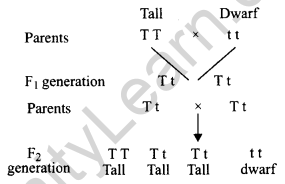
In this experiment Mendel concluded that the F1 tall plants were not true-breeding, they were carrying both short and tall height traits. They appeared tall only because the tall traits were dominant over the dwarf trait. This shows that traits may be dominant or recessive.
(b) Mendel demonstrated that traits are inherited independently through his dihybrid cross. He considered two traits at a time, seed colour and seed shape in which yellow colour (YY) and round shape (RR) are dominant over green colour (yy) and wrinkled (rr).

Mendel observed that the F2 progeny of dihybrid cross had a phenotypic ratio of 9 : 3 : 3 : 1 and produces 9 plants with round yellow seeds, three plants
with round green seed, 3 plants with wrinkled yellow and one plant with wrinkled green seeds.
In this experiment, he found that round yellow and wrinkled green are parental combination whereas round green and wrinkled yellow are new combination. In a dihybrid cross between two plants having round yellow (RRYY) and wrinkled green seeds (rryy), four types of gametes are produced (RY, Ry, ry, rY). Each of these gametes segregates independently of each other and each has a frequency of 25% of the total gametes produced.
From this experiment, he concluded that when two pairs of traits are combined together in a hybrid, one pair of character segregates independent of the other pairs of character. This is known as the law of independent assortment.
Question 22.
Analyse the following observation table showing variation of image distance (v) with object distance (u) in case of a convex lens and answer the questions that follow, without doing any calculations:
| S.No. | Object distance u (cm) | Image distance v (cm) |
| 1. | -90 | + 18 |
| 2. | -60 | + 20 |
| 3. | -30 | + 30 |
| 4. | -20 | + 60 |
| 5. | -18 | + 90 |
| 6. | -10 | + 100 |
(a) What is the focal length of the convex lens ? Give reason in support of your answer.
(b) Write the serial number of that observation which is not correct. How did you arrive at this conclusion?
(c) Take an appropriate scale to draw ray diagram for the observation at S. No. 4 and find the approximate value of magnification. [5]
Answer:
(a) From S. No. 3, we can say that the radius of curvature is 30 cm because when an object is placed at the centre of curvature of a convex lens, its image is formed on the other side of the lens at the same distance from the lens. And, we also know that focal length is half of the radius of curvature. Therefore, focal length of the lens is +15 cm.
(b) S. No. 6 is not correct as the object distance is between focus and optical centre, and in such cases, the image formed is always virtual. But in this case, a real image is formed as the image distance is positive. Therefore, v should be negative.
(c) Approximate value of magnification for object distance -20 cm and image distance +60 cm is -3.
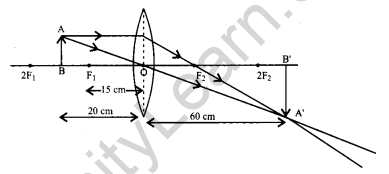
Question 23.
(a) To construct a ray diagram we use two rays which are so chosen that it is easy to know their directions after reflection from the mirror. List two such rays and state the path of these rays after reflection in case of concave mirrors. Use these two rays and draw ray diagram to locate the image of an object placed between pole and focus of a concave mirror.
(b) A concave mirror produces three times magnified image on a screen. If the object is placed 20 cm in front of the mirror, how far is the screen from the object? [5]
Answer:
(a) The following rays of light are usually used to locate the images formed by a concave mirror:
The incident ray passess through the centre of curvature : In this case, light after reflecting from the concave mirror moves back along the same path.
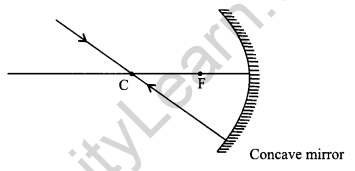
The ray incident obliquely to the principal axis: In this case, the incident ray will be reflected back by the reflecting surface of the concave mirror obliquely, making equal angles with the principal axis.
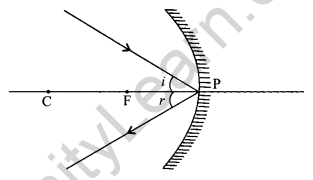
When the object is placed between pole and focus of the concave mirror, image is formed behind the mirror which is virtual, erect and magnified.
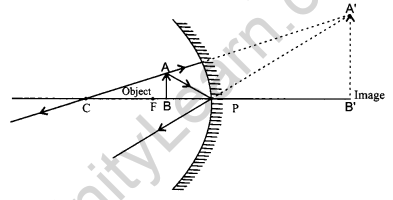
(b) Given: m = 3 (As image is real)
u = -20 cm
v = ?
We have, m = \(\frac { -v }{ u }\)
-3 = -(\(\frac { v }{ -20 }\))
v = -60 cm
The image is located at a distance of 60 cm in front of the mirror = -60 cm – (-20 cm) = -40 cm
Thus, distance between the object and the screen is 40 cm
Question 24.
(a) Draw a ray diagram to explain the term angle of deviation.
(b) Why do the component colours of incident white light split into a spectrum while passing through a glass prism, explain.
(c) Draw a labelled ray diagram to show the formation of a rainbow. [5]
Answer:
(a) The angle between incident ray, produced forward and emergent ray, produced backward is called angle of deviation D.
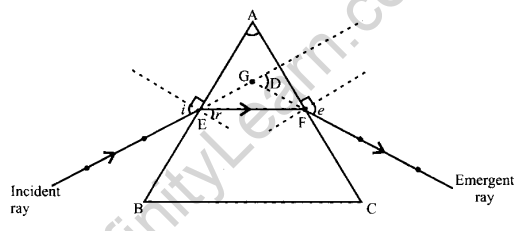
(b) The splitting up of white light into its constituent colours on passing through a refracting medium like a glass prism is called dispersion of light. The dispersion of white light occurs because different colours of light bend through different angles with respect to the incident ray, as they travel with different speeds in a prism. The red light bends the least while the violet light the most as shown below

(c) The given diagram shows the formation of rainbow in the sky.

Section – B
Question 25.
You have four test tubes, A, B, C and D containing sodium carbonate, sodium chloride, lime water, and blue litmus solutions respectively. Out of these the material of which test tube/test tubes would be suitable for the correct test of acetic/ethanoic acid? [1]
(a) Only A
(b) A and B
(c) B and C
(d) A and D
Answer:
(d) A and D
Question 26.
For demonstrating the preparation of soap in the laboratory which of the following combination of an oil and a base would be most suitable? [1]
(a) Mustard oil and calcium hydroxide
(b) Castor oil and calcium hydroxide
(c) Turpentine oil and sodium hydroxide
(d) Mustard oil and sodium hydroxide.
Answer:
(d) Mustard oil and sodium hydroxide.
Question 27.
A student took four test tubes P, Q, R and S and filled about 8 ml. of distilled water in each. After that he dissolved an equal amount of Na2SO4 in P, K2SO4 in Q, CaSO4 in R and MgSO4 in S. On adding an equal amount of soap solution and shaking each test tube well, a good amount of lather will be obtained in the test tubes: [1]
(a) P and Q
(b) P and R
(c) P, Q and S
(d) Q, R and S
Answer:
(a) P and Q
Question 28.
A student while observing an embryo of a gram seed listed various parts of the embryo as listed below:
Testa, Micropyle, Cotyledon, Tegmen, Plumule, Radicle.
On examining the list the teacher commented that only three parts are correct. Select these three correct parts: [1]
(a) Cotyledon, Testa, Plumule
(b) Cotyledon, Plumule, Radicle
(c) Cotyledon, Tegmen, Radicle
(d) Cotyledon, Micropyle, Plumule
Answer:
(b) Cotyledon, Plumule, Radicle.
Question 29.
Select the set of homologous organs from the following: [1]
(a) Wings of pigeon and a butterfly
(b) Wings of bat and a pigeon
(c) Forelimbs of cow, a duck and a lizard
(d) Wings of butterfly and a bat
Answer:
(c) Forelimbs of cow, a duck and a lizard.
Question 30.
Three students A, B and C focussed a distant building on a screen with the help of a concave mirror. To determine focal length of the concave mirror they measured the distances as given below:
Student A: From mirror to the screen
Student B: From building to the screen
Student C: From building to the mirror
Who measured the focal length correctly? [1]
(a) Only A
(b) Only B
(c) A and B
(d) B and C
Answer:
(a) Only A
Question 31.
If you focus the image of a distant object, whose shape is given below, on a screen using a convex lens.

The shape of the image of this object on the screen would be: [1]
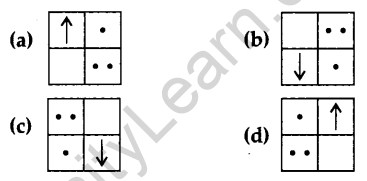
Answer:

Question 32.
In the following diagram, the correctly marked angles are: [1]
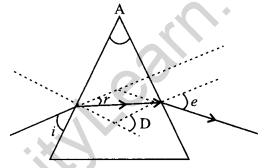
(a) ∠A and ∠e
(b) ∠i, ∠A and ∠D
(c) ∠A, ∠i and ∠e
(d) ∠A, ∠r and ∠D
Answer:
(a) ∠A and ∠e
Question 33.
The correct sequencing of the angle of incidence, angle of emergence, angle of refraction and lateral displacement shown in the following diagram by digits 1, 2, 3 and 4 is: [1]
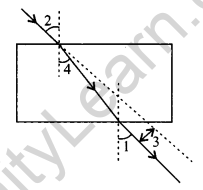
(a) 2, 4, 1, 3
(b) 2, 1, 4, 3
(c) 1, 2, 1, 4, 3
(d) 2, 1, 3, 4
Answer:
(b) 2, 1, 4, 3
Question 34.
A gas is liberated immediately with a brisk effervescence when you add acetic acid to sodium hydrogen carbonate powder in a test tube. Name the gas and describe the test that confirms the identity of the gas. [2]
Answer:
CH3COOH + NaHCO3 → CH3COONa + CO2 + H2O
Gas evolved is CO2. It is tested by passing CO2 in lime water which turns milky due to the formation of insoluble CaCO3.
Ca(OH)2 + CO2 → CaCO3 ↓ + H2O
Question 35.
Name the type of asexual reproduction in which two individuals are formed from a single parent and the parental identity is lost. Write the first step from where such a type of reproduction begins. Draw the first two stages of this reproduction. [2]
Answer:
Binary fission is the type of asexual reproduction in which two individuals are formed from a single parent and the parental identity is lost. This reproduction starts from division of nucleus i.e. karyokinesis.
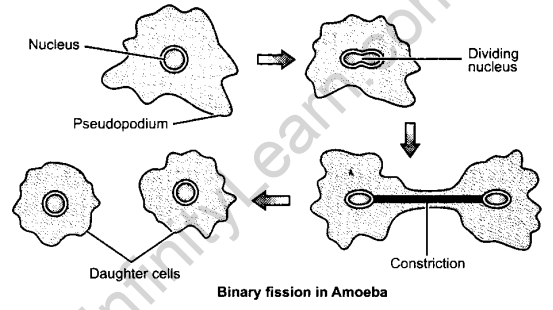
Question 36.
A student places a candle flame at a distance of about 60 cm from a convex lens of focal length 10 cm and focuses the image of the flame on a screen. After that he gradually moves the flame towards the lens and each time focuses the image on the screen.
- In which direction-toward or away from the lens, does he move the screen to focus the image?
- How does the size of the image change ?
- How does the intensity of the image change as the flame moves towards the lens?
- Approximately for what distance between the flame and the lens, the image formed on the screen is inverted and of the same size? [2]
Answer:
- He should move the screen away from the convex lens to focus the image.
- The size of the image increases.
- The intensity of the image decreases as the flame moves towards the lens.
- The flame should be placed at a distance of 20 cm from the convex lens, (i.e., at radius of curvature, R = 2f)
CBSE Previous Year Question Papers Class 10 Science 2017 Delhi Term 2 Set II
Note: Except for the following questions, all the remaining questions have been asked in previous set.
Question 1.
Write the molecular formula of first two members of homologous series having functional group -Br [1]
Answer:
General formula for the homologous series of Br group is CnH2n+1 Br
(i) CH3Br (Bromomethane)
(ii) CH3CH2Br (Bromoethane)
Question 2.
How does Planaria reproduce? Is this method sexual or asexual? [1]
Answer:
Planaria reproduces by the process of regeneration. It is a type of asexual reproduction in which planaria is cut into any number of pieces each piece grows into a new organism.
Question 3.
Why is forest considered a natural ecosystem? [1]
Answer:
Forests are considered a natural ecosystem because of the following reasons:
- They have species of plants and animals that grow without human intervention.
- All these species interact with each other and are interdependent on each other.
- These are naturally sustainable.
Question 6.
Explain how would the involvement of local people be useful for successful management of forests. [2]
Answer:
The involvement of local people will be useful for the successful management of forests in the following ways:
1. They should be aware of the fact that decrease in forest cover would disturb the ecological balance. If they show their objection against any such illegal activity that would destroy the forests, it can lead to a massive effect that will help in management of forests more effectively.
2. Phenomena’s like forest fires must be reported immediately so that necessary action can be taken soon and more area can be protected.
Question 7.
Complete the following chemical equations: [3]
- CH3COOH + Na2CO3 → ………..
- CH4 + O2 → ……….
- 2C2H5OH + Na → …………
Answer:
- 2CH3COOH + Na2CO3 → 2CH3COONa + H2O + CO2 ↑
- CH4 + 2O2 → CO2 ↑ + 2H2O
- 2C2H5OH + 2Na → 2C2H5ONa + H2 ↑
Question 8.
Two carbon compounds X and Y have the molecular formula C3H6 and C4H10 respectively. Which one of the two is most likely to show addition reaction? Justify your answer. Also, give the chemical equation to explain the process of addition reaction in this case. [3]
Answer:
C3H6 is propene i.e., an unsaturated hydrocarbon.
C4H10 is butane i.e., a saturated hydrocarbon.
Thus propene being unsaturated shows addition reaction.

Question 11.
Mention the total number of chromosomes along with the sex chromosomes that are present in a human female and a human male. Explain how in sexually producing organisms the number of chromosomes in the progeny remains the same as that of the parents. [3]
Answer:
The total number of chromosomes present in both human male and female is 46. Out of these, two chromosomes are the sex chromosomes. In human males, the two sex chromosomes present are X and Y, while in human female, both sex chromosomes are X. During sexual reproduction, the new individual is formed by the fusion of gametes from both the parents. These gametes are haploid in nature i.e., they contain only one set of the chromosomes. They are formed by the meiosis half. When these haploid gametes fuse during fertilization the nuclei of these two gametes fuse and the chromosome number is then restored to normal. Hence the progeny formed has the same number of chromosomes as that of the parents.
Question 14.
“Natural selection and speciation leads to evolution”. Justify this statement. [3]
Answer:
Natural selection is the phenomenon by which the nature selects those species which possess survival advantage over the other species. According to theory of natural selection, there is “Struggle for existence” within the species of a population for the environmental resources and this struggle leads to survival of certain organisms and elimination of the less competent species. Thus, in this competition, some organisms might undergo genetic changes which help them in their survival. The better adapted organism would, thus, survive and pass on their traits to next generations, gradually leading to evolution. Speciation is a process of formation of new species from the existing one due to reproductive isolation of a part of its population. This reproduction and isolation can occur due to geographical isolation of a part of population with time, the genetic drift will accumulate different variations in each of the geographically separated, sub-population, ultimately, all the individuals of these two groups will isolate reproductively thus, leading to formation and evolution of new species. Thus, we can say that both natural selection and speciation lead to the evolution of species on earth.
Question 16.
A 3 cm tall object is placed 18 cm in front of a concave mirror of focal length 12 cm. At what distance from the mirror should a screen be placed to see a sharp image of the object on the screen. Also calculate the height of the image formed. [3]
Answer:
Using mirror equation:
u = -18 cm, f = -12 cm, v = ?, h1 = +3 cm, h2 = ?
\(\frac { 1 }{ v }\) + \(\frac { 1 }{ u }\) = \(\frac { 1 }{ f }\)
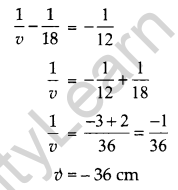
Thus, to obtain a sharp image of the object, the screen should be placed at a distance of 36 cm, in front of the mirror.
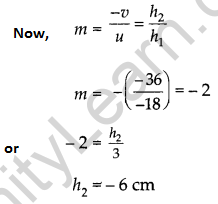
CBSE Previous Year Question Papers Class 10 Science 2017 Delhi Term 2 Set III
Note: Except for the following questions, all the remaining questions have been asked in previous sets.
Question 1.
Write the molecular formula of first two members of homologous series having functional group -OH. [1]
Answer:
The general formula for the homologous series of functional group -OH is CnH2n+1 OH
- CH3OH (Methanol)
- CH3CH2OH (Ethanol)
Question 2.
How does Plasmodium reproduce? Is this method sexual or asexual? [1]
Answer:
Plasmodium reproduces by a process known as multiple fission. Multiple fission is a type of asexual reproduction in which a single parent cell divides into several daughter individuals. In this process, the parent nucleus divides several times into a number of daughter nuclei. Later the cytoplasm divides into as many pieces as the number of nuclei and each piece surrounds each nucleus. Each uninucleated piece develops an outer membrane and finally the parent cell divides into several uninucleate individuals.
Question 3.
Why is lake considered to be a natural ecosystem? [1]
Answer:
A lake is considered as a natural ecosystem as it consists of both biotic and abiotic components, both these components in a lake are interdependent and do not require any human interference for their sustenance.
Question 4.
An object is placed at a distance of 12 cm in front of a concave mirror of radius of curvature 30 cm. List four characteristics of the image formed by the mirror. [2]
Answer:
The characteristics of the image formed by the concave mirror will be virtual, erect, enlarged and laterally inverted.
Question 5.
How do advantages of exploiting natural resources with short term gains in mind differs from the advantages of managing our resources with a long term perspective? [2]
Answer:
Exploitation of natural resources with short-term gains aims at providing all the benefits to the current generation for their growth and development without any consideration for the future. To obtain these gains, a large number of exhaustible resources are being used extensively which has detrimental effects on our environment. In case of long term perspective, the resources are utilised in a more judicious manner so that they are also conserved for future generations. It ensures uniform distribution among the people. Also, the resources are utilised in a more eco¬friendly manner which is advantageous for environment.
Question 6.
What is meant by wildlife ? How is it important for us? [2]
Answer:
Wildlife refers to all the naturally occurring plants, animals, birds and other life forms which are found in the forests and are not domesticated.
Importance of wildlife:
- It is essential to maintain the ecological balance of nature.
- It provides a great biological diversity in an area.
- It serves as a source of various valuable products, such as drugs, honey lac, coory decorative leather, etc.
Question 7.
Complete the following chemical equations: [3]

Answer:
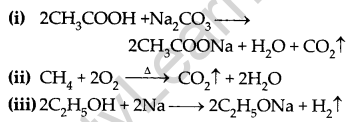
Question 8.
The molecular formula of two-carbon compounds is C4H8 and C3H8. Which one of the two is most likely to show addition reaction? Justify your answer. Also give the chemical equation to explain the process of addition reaction in this case. [3]
Answer:
1. C4H8: Butene- alkene (unsaturated hydrocarbon)
2. C3H8: propane-alkane (saturated hydrocarbon)
C4H8 i.e., butene shows addition reaction as it is an unsaturated hydrocarbon
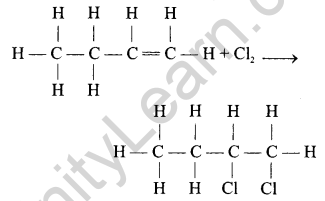
Question 14.
List any four steps involved in sexual reproduction and write its two advantages? [3]
Answer:
The steps involved in sexual reproduction are as follows:
- Formation of gametes through meiosis.
- Transfer of male gametes into the female body.
- Fertilisation (fusion of male and female gametes).
- Post fertilisation changes.
Advantages of sexual reproduction:
- It is a source of genetic variation among individuals of a population.
- It gives rise to individuals that are more adapted to the environment.
Question 17.
Write about power of accommodation of human eye. Explain why the image distance in the eye does not change when we change the distance of an object from the eye? [3]
Answer:
The ability of the eye to see the object, at varying distances, clearly by adjusting the focal length of its lens is called power of accommodation.
The focal length of the human eye can change i.e. increase or decrease, depending on the distance of objects and due to this the image distance in the eye does not change. When the distance of an object is changed from the eye, it is the ciliary muscles that modify the curvature of the lens to change its focal length.
